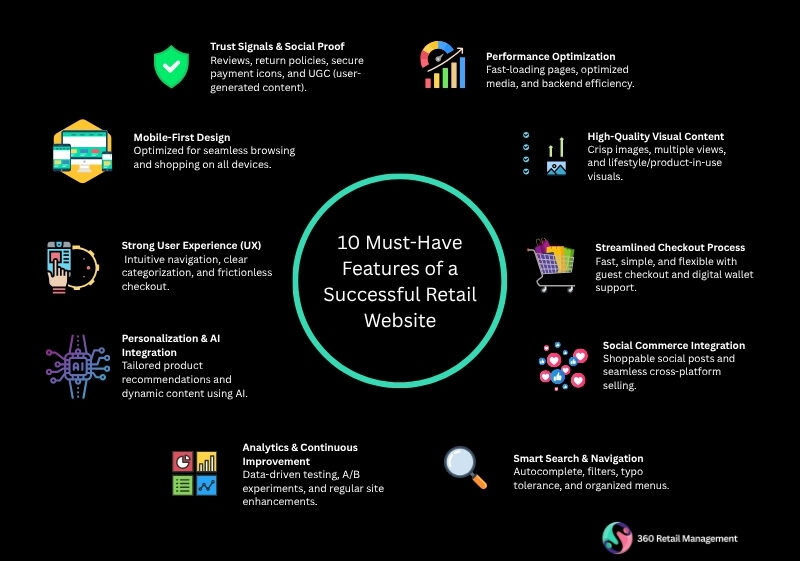
Key Features of an Effective Retail Website: A Comprehensive Guide
In today’s digital-first marketplace, your retail website is the primary touchpoint between your brand and customers. With online shopping evolving rapidly, understanding what makes a retail website truly effective has become crucial for business success. This comprehensive guide explores the essential features that can transform your website from a digital storefront into a powerful conversion engine.
At 360 Retail Management, we help independent retailers build websites that look great and are designed to convert. From layout and functionality to performance optimization, we ensure your site supports your business goals and delivers real results.

- 1. Mobile-First Design: The Foundation of Modern Retail
Mobile responsiveness isn’t optional anymore, it’s fundamental. As noted by BigCommerce, mobile commerce is expected to account for more than 10% of all retail sales in the United States by 2025. A mobile-optimized website ensures customers can browse, compare, and purchase products seamlessly across all devices. This means implementing responsive design principles, touch-friendly navigation, and fast-loading pages that perform well on slower mobile connections.
- 2. User Experience: The Conversion Game-Changer
- User experience (UX) has emerged as the ultimate differentiator in retail success. According to RevLifter, a better UX design can increase conversions by up to 400%, and 84% of customers say the experience a retailer provides matters more than the products themselves. Moreover, every dollar invested in UX can yield an ROI of $100, making it one of the most cost-effective investments for retail businesses.
The key to exceptional UX lies in reducing friction throughout the customer journey, intuitive navigation, clear product categorization, and a streamlined checkout process that minimizes form fields and clicks.
- 3. Personalization and AI Integration
Modern retail websites are increasingly leveraging artificial intelligence to deliver hyper-personalized experiences. As highlighted in Lounge Lizard’s 2025 website design best practices, hyper-personalization now goes beyond simple customization. It involves AI and machine learning to analyze user behavior, preferences, and history, enabling features like tailored product recommendations, dynamic content, and customized landing pages.
- 4. High-Quality Visual Content and Product Presentation
Visual storytelling is more important than ever. E-commerce leaders like Shopify emphasize that high-resolution, professional imagery, including multiple product angles, zoom capabilities, and lifestyle visuals, can significantly improve engagement and conversion. Advanced features like 360-degree views and AR previews help replicate the in-store experience online.
- 5. Streamlined Checkout and Payment Options
Cart abandonment remains a major issue in retail, with an average abandonment rate of 69.57%, according to UserTesting. Leading causes include unexpected costs, long checkout processes, and a lack of payment flexibility. The solution? Offer guest checkout, multiple payment options (including digital wallets), clear pricing, and progress indicators that guide users through the process smoothly.
- 6. Trust Signals and Social Proof
Establishing trust is crucial, especially for first-time buyers. Key trust-building features include customer reviews and ratings, visible SSL security badges, clear return policies, and user-generated content. These elements provide the social proof needed to overcome hesitation and increase conversions.
- 7. Site Performance and Technical Excellence
Speed matters. Pages should load in under three seconds to avoid losing impatient users. Tactics like image optimization, CDNs, and caching all contribute to a faster and more reliable experience, important not just for customers but for SEO rankings, too. Elementor notes that performance optimization is often the difference between a good and great e-commerce experience.
- 8. Search Functionality and Navigation
A robust search experience empowers customers to find what they need quickly. Effective features include autocomplete, smart filters, typo tolerance, and even visual search. When combined with intuitive navigation menus and logical product categorization, customers enjoy a smoother path from browsing to buying.
- 9. Integration with Social Commerce
With the rise of social shopping, modern retail websites must integrate with platforms like Instagram, Facebook, and TikTok. Features like social logins, shoppable posts, and easy sharing enhance customer interaction and enable an omnichannel shopping journey that meets consumers where they already spend their time.
- 10. Analytics and Continuous Optimization
Effective retail websites are living platforms. Use analytics tools to track user behavior, identify bottlenecks, and test improvements through A/B testing. As consumer expectations and technology shift, your site must evolve in response. Continuous optimization is what separates industry leaders from the rest.
Conclusion
Creating an effective retail website requires balancing aesthetic appeal with functional excellence. Retailers can build digital platforms that attract customers and convert browsers into loyal buyers by focusing on mobile optimization, user experience, personalization, and continuous improvement. As the digital landscape continues to evolve, staying ahead of these trends will be crucial for maintaining a competitive advantage in the online retail space.
Looking to improve or launch a website for your retail business? 360 Retail Management offers expert strategy, design, and support to help you build a high-performing site tailored to your brand and customers.
Let’s create a site that doesn’t just look good, but drives measurable growth.



